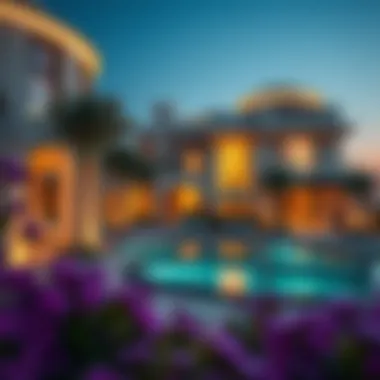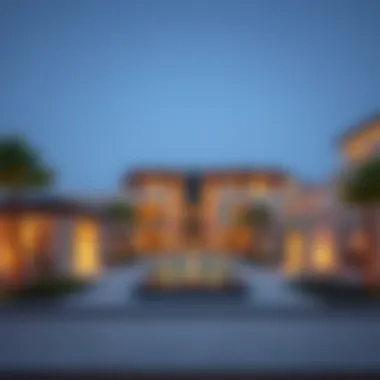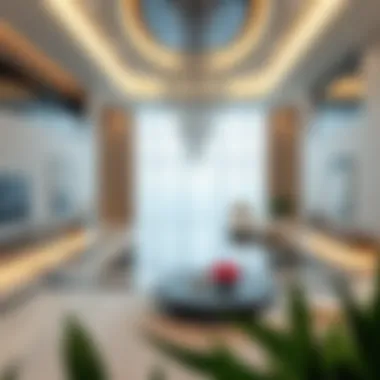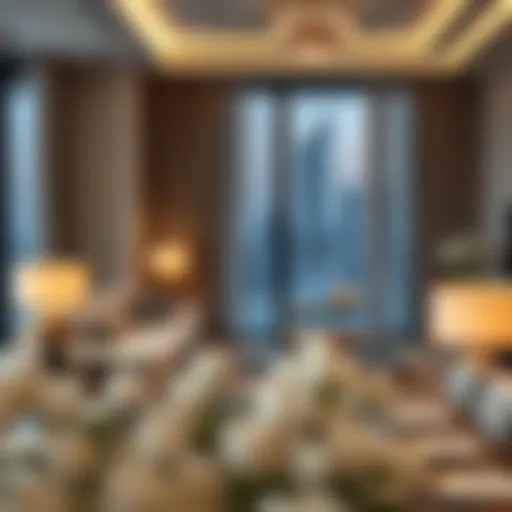Exploring Pan Homes: Real Estate Trends in Dubai


Intro
Dubai's real estate market stands tall, rising yet again with a unique segment known as pan homes. These properties offer an appealing mix of luxury and practicality, capturing the eyes and wallets of both investors and homeowners alike. They boast an architectural style that’s distinctively futuristic yet comfortably homey, making them a tempting option for those looking to invest or settle down in this bustling metropolis.
With the city's ever-evolving skyline and cultural diversity, pan homes represent a particular niche within Dubai's expansive property market. They cater to a variety of lifestyles and price points, thus appealing to a broader audience. This article seeks to unpack the layers surrounding pan homes, discussing everything from market trends to investment opportunities, with the aim of offering a comprehensive overview.
Stay tuned as we delve deeply into the current landscape, analyze investment prospects, and explore how these homes fit into the larger tapestry of Dubai's urban environment.
Property Market Overview
Current Market Trends
Dubai's property market has shown resilience over the past several years, adapting to economic fluctuations and demographic changes. Some notable trends currently shaping the landscape include:
- Increased Demand for Eco-Friendly Homes: An uptick in environmental awareness has prompted a rise in interest toward energy-efficient and sustainable homes. Buyers are increasingly inclined to seek out properties that reduce their carbon footprint.
- Shift to Remote Work: The pandemic has altered work dynamics, leading many to prioritize homes that provide comfort and space for remote working arrangements.
- Market Recovery: After a period of stagnation, the real estate market in Dubai is experiencing a rebound, with investment activity on the rise, translating into increased property values.
These trends not only outline the current real estate atmosphere but also indicate areas where pan homes can thrive, especially if they cater to environmental concerns and flexible living spaces.
Key Statistics and Performance Indicators
Understanding key statistics and performance indicators is critical for making informed decisions in the property market. Here are some noteworthy highlights:
- Average Price per Square Foot: As of late 2023, the average price per square foot for pan homes in key areas such as Dubai Marina and Downtown Dubai is approximately AED 1,500, reflecting an upward trend in desirability.
- Investment Growth: International investors are increasingly pouring capital into Dubai real estate, with a reported increase of 10% year-on-year in transactions.
- Occupancy Rates: Pan homes have seen occupancy rates soar, typically hovering around 85%, highlighting their desirability among residents.
These statistics not only empower potential buyers but also provide investors with a solid grounding when evaluating the viability of pan homes in today's market.
Investment Opportunities
Emerging Neighborhoods for Investment
When pondering over investment prospects in pan homes, consider these emerging neighborhoods that are garnering attention:
- Dubai Hills Estate: This area is fast becoming a sought-after locale due to its spacious homes and proximity to green spaces.
- Mohammad Bin Rashid City: Targeting luxury seekers, this neighborhood is rich in amenities, set to attract high-net-worth individuals.
- Jumeirah Village Circle (JVC): Known for its affordability and community vibe, JVC is a growing hotspot for young families and new buyers.
Investors should not overlook these areas, as they present promising opportunities for significant returns, especially with the right approach and timing.
Buying vs. Renting: Pros and Cons
In the dynamic landscape of Dubai’s real estate market, potential homeowners often find themselves torn between buying and renting pan homes. Here’s a deeper look at the benefits and drawbacks of each option:
Buying
- Pros:
- Cons:
- Long-term investment security and potential property appreciation
- Customized living experiences through renovations or improvements
- Upfront costs can be daunting, including down payments and fees
- Market fluctuations can affect property values
Renting
- Pros:
- Cons:
- Flexibility to change living situations without long-term commitments
- Lower initial costs compared to buying
- No equity build-up in rental properties
- Rent costs may increase, depending on market conditions
Both options have merits, and potential homeowners should weigh these characteristics against their personal circumstances and financial goals.
> Investing in pan homes goes beyond merely purchasing property; it’s about understanding the lifestyle, community, and future potential of real estate in this vibrant city.
For further insights into the real estate sector in Dubai, consider exploring market reports from the Dubai Land Department, which regularly updates housing trends and investment opportunities.
Preface to Pan Homes
The concept of pan homes represents a significant edge in the competitive real estate landscape of Dubai. These properties offer a unique blend of modern design and functionality, catering to a diverse range of homeowners and investors. Understanding pan homes is essential for anyone considering entering this dynamic market. From their architectural appeal to their alignment with contemporary lifestyle needs, pan homes are not just residences; they symbolize a shift towards more sustainable and versatile living solutions.
Defining Pan Homes
At their core, pan homes can be characterised as flexible living spaces often designed with multipurpose functionality in mind. Distinct from traditional homes, they emphasize open-plan layouts, which provide versatility for various activities—be it work, relaxation, or social gatherings. These homes frequently feature expansive windows, allowing for natural light to flood the living spaces, enhancing both aesthetics and energy efficiency.


Furthermore, pan homes often incorporate innovative building materials and techniques that support sustainability goals. It's not uncommon to find features like solar panels, rainwater collection systems, or energy-efficient appliances, all integral parts of modern pan home design.
The Popularity of Pan Homes in Dubai
The rising attraction of pan homes in Dubai stems from a fusion of cultural and economic trends. The vibrant lifestyle in this emirate has led to a growing demand for properties that align with the active, multicultural life that Dubai promotes. In particular, young professionals and families are drawn to these homes due to their adaptability. They are not simply residences but also spaces that can evolve with the homeowner’s changing needs over time.
Additionally, the luxury market in Dubai has embraced the pan home model, often integrating high-end amenities and smart home technology. This appeal has been amplified by targeted marketing strategies showcasing the lifestyle benefits associated with pan homes. People are looking beyond the four walls; they seek environments that nurture relationships, productivity, and well-being.
In essence, as the city of Dubai continues to grow and evolve, so does the concept of what a home should be. Understanding pan homes offers invaluable insights into current market dynamics, emphasizing the importance of incorporating flexibility, sustainability, and design innovation in residential properties.
Architectural Features of Pan Homes
Understanding the architectural features of Pan homes is like piecing together a puzzle that reveals a striking image of modern living. These properties are not just structures; they embody a lifestyle and an approach to sustainable housing that resonate with the contemporary homeowner. Each architectural element serves a purpose and blends seamlessly into the overall design, enhancing not only aesthetics but also functionality.
Design Concepts
Pan homes in Dubai showcase innovative design concepts that prioritize open spaces and natural light. These homes are typically characterized by their fluid layouts, which promote a seamless flow from one area to another. High ceilings and large windows allow for a generous influx of daylight, creating an inviting atmosphere that feels expansive yet intimate.
The integration of indoor and outdoor spaces is a hallmark of pan home design. For instance, bi-fold doors that open onto landscaped gardens or patios extend living areas, blurring the line between the indoors and outdoors. This setup is perfect for the Dubai climate, where outdoor living can be enjoyed throughout much of the year.
Key Features of Design Concepts:
- Open Floor Plans: Prioritize space and connectivity between rooms.
- Natural Light: Use of large windows enhances brightness and warmth.
- Indoor-Outdoor Integration: Designs that extend living areas into exteriors.
- Sustainable Materials: Often incorporate eco-friendly materials to reduce environmental impact.
Sustainable and Eco-friendly Practices
In a world increasingly conscious about environmental footprints, pan homes in Dubai stand out for their commitment to sustainability. The architectural features often incorporate energy-efficient systems. Solar panels, high-quality insulation, and smart home technologies are common elements that not only help in reducing energy costs but also contribute to a greener environment.
Moreover, the designs often include rainwater harvesting systems and greywater recycling to minimize water wastage. This eco-conscious approach not only supports sustainable living but can also enhance property value in a market that increasingly favors environmentally responsible investments.
Aspects of Sustainable Practices:
- Energy-efficient Systems: Solar panels and LED lighting options.
- Water Management: Rainwater collection and greywater systems.
- Sustainable Materials: Use of reclaimed wood and recycled resources.
- Smart Home Features: Technologies that enhance energy management.
Interior Design and Customization
One of the appealing aspects of pan homes is the flexibility they offer in interior design and customization. Homeowners can tailor their spaces to reflect personal style without sacrificing functionality. The interiors often showcase contemporary finishes, blending minimalist aesthetics with warmth through the use of wood and stone accents.
What makes pan homes particularly attractive is their adaptability. Whether opting for a chic urban vibe with sleek lines or a cozy, rustic feel with earthy tones, the design concepts allow for a spectrum of influences. This capability for customization empowers homeowners to express their individuality, creating spaces that truly feel like home.
Customization Options to Consider:
- Flooring Choices: Wide array of options from tiles to hardwood.
- Color Palettes: Selection that matches personal taste and style.
- Furnishings: Ability to choose built-ins or free-standing pieces.
- Lighting Fixtures: Selection of modern or contemporary designs to enhance the atmosphere.
''The true value of a home lies not just in the bricks and mortar but in the heart and soul within.''
Market Trends Affecting Pan Homes
The landscape of real estate is always shifting, and in Dubai, the focus on pan homes has become a compelling area of interest. Understanding the market trends affecting these properties is essential for investors and homeowners alike. As we explore this segment, we will dive into various aspects that define the current dynamics in the housing market, the preferences of buyers, and how broader economic influences play a crucial role.
Current Market Overview
Currently, the market for pan homes in Dubai showcases a vibrant mix of demand and supply, influenced by evolving buyer needs and local developments. The allure of unique architectural designs, modern amenities, and sustainable features has attracted a diverse range of prospective homeowners and real estate investors.
It’s worth noting that, over the past few years, property values have seen a considerable rise, often outpacing increases in rental prices. This phenomenon has heightened interest in ownership, particularly among families and young professionals. Moreover, areas like Dubai Marina and Jumeirah Village Circle are emerging as favorites due to their strategic locations and lifestyle offerings.
"The trend towards contemporary living solutions in urban settings has given rise to significant interest in pan homes, blending luxury with practicality."
Buyer Preferences and Demographics
Understanding who is buying pan homes can help pinpoint the factors driving demand. Current buyers are often a mix of expatriates, millennials, and affluent locals, which significantly impacts design and features they seek. For families, ample space, safety, and proximity to educational institutions tend to top the list. Meanwhile, younger professionals are frequently drawn to modern, minimalist designs with smart home technology.
- Key Buyer Demographics:
- Young professionals aged 25-35 are seeking low-maintenance homes that offer modern conveniences.
- Families with children favor neighborhoods known for their schooling options.
- Investors lean towards areas that promise high rental yields and potential for property value increases.
Economic Influences and Trends
The broader economic landscape plays a crucial role in shaping trends in the pan home sector. With Dubai's economy rebounding, thanks in part to tourism and investments in infrastructure, the real estate market is benefiting greatly. However, fluctuating oil prices and global economic uncertainties can also create headwinds.


Regulatory changes, tax structures, and incentives for property buyers often tilt the scales of interest. For instance, the introduction of long-term visas for expatriates has encouraged many to invest more heavily in property, as they seek stability and community.
- Factors Influencing Economic Trends:
- Ongoing investment in infrastructure projects, such as transport and public amenities.
- Changing regulations that either encourage or dissuade foreign investment in real estate.
- The vitality of tourism overall, affecting demand for rental properties.
Staying abreast of these trends can provide valuable insights into the potential for pan homes, equipping buyers and investors with the knowledge needed to make well-informed decisions.
Investment Potential of Pan Homes
The investment potential of pan homes in Dubai is a critical aspect that deserves thorough examination, particularly for those considering entering the real estate market. Dubai has become a global hub for real estate investment, and pan homes stand out for their unique features and high demand among buyers and renters alike.
Analyzing the investment opportunities inherent in pan homes involves understanding several key elements: long-term value appreciation, rental yield assessment, and a comparative analysis with other real estate investments.
Long-Term Value Appreciation
When investing in pan homes, the prospect of long-term value appreciation is one of the prime reasons to consider them as a viable option. Historically, Dubai's real estate market has witnessed significant price surges, and pan homes are no exception.
Factors contributing to this appreciation include:
- Strategic Location: Many pan homes are situated in highly coveted neighborhoods, which often leads to better property values over time.
- Quality Construction: Pan homes generally employ superior building standards and materials, ensuring they maintain their appeal in a competitive market.
- Increasing Demand: As the population in Dubai continues to grow, the demand for housing—especially modern designs like pan homes—remains high.
Investors looking towards the future can expect a positive trajectory in property values, particularly if they choose homes with optimal locations and architectural designs that resonate with buyer preferences.
Rental Yield Assessment
For those considering pan homes strictly from a rental investment standpoint, yield assessment is paramount. The rental market in Dubai offers lucrative opportunities, and pan homes can deliver impressive rental returns due to several factors:
- Desirable Living Experience: Pan homes often feature contemporary designs and amenities. This makes them attractive to both short-term and long-term renters, leading to lower vacancy rates.
- Attractive Amenities: Many pan homes come with a palette of community offerings—from swimming pools to gyms—which draws renters seeking a lifestyle rather than just a roof over their heads.
- Rental Market Dynamics: The demand for rental properties in Dubai has been consistently strong, particularly among expatriates and young professionals, which directly benefits owners of pan homes.
As such, potential investors should thoroughly analyze the projected rental returns, perhaps leaning on local property managers to gauge market rental rates in various neighborhoods.
Comparative Analysis with Other Real Estate Investments
Taking stock of pan homes’ potential requires understanding how they stack up against other forms of real estate investments. Given their unique offerings, pan homes can be more appealing than traditional villas or apartments. Consider the following:
- Higher Appreciation Rates: In some areas, pan homes have shown faster appreciation than traditional investments.
- Flexibility of Use: These homes can cater to diverse markets, appealing to both those looking to buy versus those who might prefer renting. This flexibility can create opportunities for maximizing profit.
- Sustainability Factor: The more eco-friendly design principles often employed in pan homes can appeal to a growing demographic of environmentally conscious buyers.
Neighborhoods Featuring Pan Homes
The exploration of pan homes in Dubai cannot be complete without a thorough understanding of the neighborhoods that host these unique residences. The location of a pan home significantly affects its value, lifestyle offerings, and desirability among potential buyers and investors. Each neighborhood in Dubai brings a distinct flavor, showcasing varied architectural elements, cultural influences, and demographic mixes that are crucial for any prospective homeowner or investor to understand.
Key Areas for Pan Homes
When it comes to pan homes, certain key areas stand out due to their strategic location, amenities, and overall ambience. Some notable locales include:
- Jumeirah Village Circle (JVC): This area is popular among families and young professionals. The pan homes here typically feature spacious layouts and are surrounded by parks and community facilities.
- Dubai Marina: Often viewed as a prime spot for luxury living, pan homes in this neighborhood offer breathtaking views and easy access to waterfront activities. This cosmopolitan area attracts many affluent expatriates and investors.
- Arabian Ranches: It’s known for its serene environment and family-friendly atmosphere. The design of pan homes here often incorporates traditional Arabian motifs, appealing to buyers looking for a community feel.
- Dubai Hills Estate: This upcoming area is rapidly gaining reputation for its high-end amenities and architectural diversity. With an integration of green spaces, pan homes in Dubai Hills Estate are positioned as future-forward living spaces.
Each of these locations provides unique advantages, whether it be proximity to schools, shopping centers, or recreational areas. It’s essential for buyers to consider their personal lifestyle and needs when evaluating options.
Amenities and Accessibility
A significant aspect that sets pan homes apart in Dubai is the amenities available within the neighborhoods they inhabit. With the city’s rapid development, many of these areas are equipped with a wealth of facilities intended to enhance living quality:
- Parks and Recreational Facilities: Many neighborhoods are designed with lush green parks, playgrounds, and sports facilities. This caters especially to families looking for outdoor spaces.
- Retail Options: Easy access to shopping centers or local markets is a pivotal factor. Neighborhoods like Jumeirah Village Circle provide a medley of retail options right at residents’ doorsteps.
- Public Transport Links: Areas with strong connectivity through metro and bus services ensure that commuting is a breeze. Dubai Marina, for instance, is well-served by public transport, making daily travel easier for its residents.
- Healthcare and Education: Proximity to reputable schools and healthcare facilities can greatly influence buyer choices. Neighborhoods boasting access to quality services are often more attractive.
"In real estate, location is not just a consideration; it is often the determining factor for long-term satisfaction and investment success."
Regulatory and Legal Considerations
Exploring the realm of pan homes in Dubai without delving into regulatory and legal considerations would be akin to navigating a ship without a compass. Property laws in the UAE are multifaceted, often interwoven with cultural traditions and unique legal frameworks. Understanding these elements is crucial for potential buyers, homeowners, and investors alike. The significance here lies in ensuring that any investment made is sound, secure, and adheres to local regulations. This section aims to outline essential aspects of property laws and the procedural framework that governs the purchase of pan homes in Dubai.
Understanding Property Laws
When it comes to property laws in Dubai, clarity is key. The Real Estate Regulatory Agency (RERA) lays down the groundwork for these laws, which offers a framework not only for ownership but also for transactions. A few critical components of these laws include:
- Ownership Rights: Non-UAE nationals can own properties in designated areas, which fosters foreign investment. These zones are often characterized as freehold areas, where foreign ownership is fully permitted. Understanding which areas fall under this classification is vital.
- Leasehold vs. Freehold: Buyers often face a choice between leasehold and freehold ownership. While freehold grants full ownership, leasehold usually provides rights for a specified number of years, often up to 99. This distinction is important depending on the buyer's long-term plans.
- Strata Laws: Strata laws govern the management and use of communal properties, crucial for those considering apartment-style or shared living arrangements within pan homes. These may dictate rules on property management and maintenance, thereby influencing the overall living experience.
When navigating these laws, it is often advised to consult legal professionals specializing in UAE property. This step helps ensure compliance and can prevent potential legal hiccups down the line.


Documentation and Procedures for Purchase
The documentation and procedures involved in purchasing pan homes in Dubai might seem complex at first glance, yet breaking it down can simplify the process considerably. Here's an overview of what to expect:
- Pre-Approval for Financing: Begin with obtaining pre-approval from banks if financing is needed. This not only helps set a budget but also boosts negotiation power.
- Reservation and Sales Agreement: Once a suitable property is located, the buyer will need to sign a Reservation Agreement, followed by a Sale Purchase Agreement (SPA). These documents formalize the intention to purchase and outline the terms and conditions.
- No Objection Certificate (NOC): The developer must provide an NOC, confirming there are no outstanding dues or liens against the property. This certificate acts as a safeguard for the buyer.
- Final Transfer of Ownership: This step is crucial and happens at the Dubai Land Department. The buyer needs to present all documentation, such as the SPA, NOC, and proof of payment. Once duly processed, the transfer of ownership is complete, and registration occurs.
Purchasing a pan home isn't quite a walk in the park, but being well-informed about local laws and procedures makes it a less daunting task.
"Knowing the rules before stepping into the game is half the victory."
By mastering these regulations and understanding the necessary documentation, investors can navigate the Dubai real estate market more effectively, positioning themselves for success in acquiring a pan home.
Challenges Facing Pan Homes in Dubai
Navigating the landscape of pan homes in Dubai is akin to walking a tightrope; while these properties boast unique characteristics and design, they are not devoid of hurdles that can complicate ownership and investment. Addressing these challenges is essential for both prospective homeowners and investors, as understanding these obstacles can offer insights into market behavior and future potential.
Market Saturation and Competition
The real estate sector in Dubai has been evolving rapidly, leading to significant market saturation in recent years, especially regarding pan homes. The boom in construction and an influx of new developers have created a crowded marketplace where distinguishing one's offerings becomes increasingly difficult. With numerous options available, buyers can be more discerning, leading to heightened competition among sellers.
- Increased Listings: As many developers unveil similar designs and amenities, buyers experience analysis paralysis, making it tough for a single property to stand out.
- Price Wars: To attract buyers, sellers may feel the pressure to lower prices, which can lead to decreased property values overall.
- Quality Concerns: With many pan homes coming onto the market, inconsistencies in quality may arise. Prospective buyers need to be vigilant, scrutinizing each property to ensure it meets the desired standards.
In summary, the saturation of the market forces stakeholders to be strategic. Understanding shifts in buyer preferences and adapting to the new dynamic is essential for maintaining a competitive edge.
Economic Downturn Risks
The real estate market in Dubai is susceptible to economic fluctuations just like any other sector. Such downturns can lead to diminished investments in pan homes for various reasons.
- Reduced Consumer Confidence: Economic instability can lead to buyers second-guessing their decisions, affecting the willingness to invest in real estate. People tend to hold onto their finances when uncertainty looms, which can lead to lower demand for pan homes.
- Increased Financial Regulations: A downturn may lead to stricter lending criteria for mortgages. This can limit the pool of potential buyers for pan homes, making it more difficult to sell or lease properties.
- Resale Issues: Should an economic decline occur, properties may not only face diminishing value, but also prolonged sales periods. Homeowners could find themselves in a tight spot, as their ability to sell at an acceptable price diminishes.
In essence, economic downturns can have rippling effects on pan homes, influencing everything from consumer spending habits to investment opportunities. Keeping an eye on broader economic indicators becomes crucial for anyone involved in the Dubai real estate scene.
Future Outlook for Pan Homes
The future of pan homes in Dubai is a topic of great significance, intertwining elements of design innovation, market dynamics, and shifting consumer preferences. As the city continues to evolve, so do the expectations and demands of its residents and investors alike. Understanding the trends shaping this landscape can equip buyers and professionals with the knowledge they need to navigate potential opportunities and challenges. The relevance of this section is clear; it’s not just about appreciating aesthetically pleasing properties but recognizing their value in a fast-paced real estate market.
Emerging Trends in Home Design and Construction
Design and construction methods are undergoing rapid changes, reflecting advancements in technology and environmental consciousness. Many architectural firms are integrating smart home technologies into pan homes. Features such as automated systems for lighting, security, and climate control are not just perks anymore; they’re becoming standard. Homeowners expect efficiency and sustainability in their living spaces, leading to designs that prioritize energy saving and eco-friendly materials.
An important note is the surge in use of prefabricated components in home building. This method allows for faster construction time while lowering labor costs. In turn, these reductions can make pan homes more appealing financially.
Key trends in design include:
- Open Plan Living: This style maximizes space and fosters a community feel within the home.
- Biophilic Design: Bringing the outdoors in, utilizing natural light, and local flora in conceptualization to enhance well-being.
- Adaptable Spaces: Homes are increasingly designed to be flexible, allowing for customization and future adaptations as family needs change.
Predictions for Market Growth
Looking ahead, the market for pan homes in Dubai presents substantial growth potential. The city’s population continues to expand, fueled by expatriates and new business ventures. This influx is likely to maintain demand for innovative housing solutions, particularly in prime locations.
Analysts suggest that over the next decade, we might see:
- An increase in property values in areas where pan homes are prevalent. Given Dubai’s status as a global city, this does not come as a surprise.
- A rise in investment from abroad, as many international buyers view Dubai as an emerging market with strong prospects for real estate growth.
- Enhanced competition among developers, pushing them to provide more attractive and cutting-edge designs to lure buyers.
"Market growth in Dubai real estate remains robust, driven by diverse population needs and ongoing urban expansion, making pan homes a compelling option for investment."
In summary, the future of pan homes in Dubai appears bright, with innovative designs meeting the demands of an evolving market. Investors and homebuyers should keep a keen eye on these trends, as they not only dictate current valuations but also hint at potential future returns.
End
In navigating the landscape of pan homes in Dubai, a rich tapestry of insights emerges, shedding light on their unique appeal and intrinsic value. Understanding this topic goes beyond mere property details; it encompasses lifestyle choices, investment strategies, and market dynamics that shape the decisions of homeowners and investors alike.
Summarizing Key Insights
Throughout this comprehensive exploration, we've uncovered several key insights:
- Architectural Distinction: Pan homes stand out with their combination of contemporary designs that often fuse modern aesthetics with functionality. This distinguishes them from traditional homes in the area, providing a broad appeal to diverse demographics.
- Market Relevance: The popularity of pan homes continues to rise, driven by shifting buyer preferences and the growing demand for sustainable living environments. Understanding these trends is crucial for anyone looking to invest or reside in Dubai's competitive real estate market.
- Investment Viability: The analysis of potential returns on investment underscores the growing value of pan homes. Factors such as location, amenities, and future development plans add layers of consideration for potential buyers.
In summary, those interested in Dubai's property sector must pay attention to these insights, enabling them to make more informed and strategic decisions in their real estate pursuits.
Final Thoughts on Investing in Pan Homes
Investing in pan homes transcends simply acquiring property; it represents a holistic lifestyle choice and a commitment to sustainability. As investors or potential homeowners contemplate this journey, several considerations come into play:
- Lifestyle Alignment: A pan home often offers a lifestyle that balances luxury with ecological consciousness. Buyers should consider how these values resonate with their own lifestyle aspirations.
- Market Movement: Keeping a finger on the pulse of market trends is essential. As outlined earlier, shifts in buyer demographics and preferences will impact the long-term viability and appreciation of pan homes.
- Financial Planning: Assessing financial implications, such as loan options or potential rental yields, is imperative for making prudent investments.







